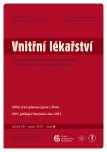Renal denervation 2013
Authors:
J. Špinar 1; J. Vítovec 2; L. Špinarová 2
Authors‘ workplace:
Interní kardiologická klinika Lékařské fakulty MU a FN Brno, pracoviště Bohunice, přednosta prof. MU Dr. Jindřich Špinar, CSc., FESC
1
Published in:
Vnitř Lék 2013; 59(8): 724-729
Category:
Overview
Arterial hypertension is a worldwide serious clinical problem. It affects 30– 40% of the adult population. Resistant hypertension is defined as systolic blood pressure that remains ≥ 140mmHg while in the doctor’s surgery and/ or as average systolic blood pressure during a 24- hour monitoring of an outpatient ≥ 130mmHg after a combination of three antihypertensive agents (including a diuretic) has been administered in the maximum tolerated dose amounts. Renal denervation is an invasive method of catheter radio frequency ablation of sympathetic nerves located in the walls of renal arteries. The results of the Symplicity HTN‑ 1 and HTN‑ 2 trials proved that renal denervation can safely decrease blood pressure in patients with resistant hypertension. Further research is necessary in order to verify these data, to clarify the questions which remained unanswered and to evaluate future applications of renal denervation. Current experience and recommendations are included, as well as an overview of existing denervation devices and devices which are in development.
Key words:
resistant hypertension – renal denervation of the sympathetic nervous system – Symplicity trial
Sources
1. Filipovský J, Widimský J Jr, Ceral J et al. Diagnostické a léčebné postupy u arteriální hypertenze – verze 2012. Doporučení České společnosti pro hypertenzi. Vnitř Lék 2012; 58: 785– 802.
2. Cífková R, Bruthans J, Adámková V et al. Prevalence základních kardiovaskulárních rizikových faktorů v české populaci v letech 2006– 2009. Studie Czech post‑MONICA. Cor Vasa 2011; 53: 220– 229.
3. Mancia G, De Backer G, Dominiczak A et al. 2007 Guidelines for the Management of Arterial Hypertension: The Task Force for the Management of Arterial Hypertension of the European Society of Hypertension and of the European Society of Cardiology (ESC). J Hypertens 2007; 25: 1105– 1187.
4. Mancia G, Laurent S, Agabiti‑ Rosei E et al. Reappraisal of European guidelines on hypertension management: a European Society of Hypertension Task Force document. J Hypertens 2009; 27: 2121– 2158.
5. Vysočanová P. Renální denervace a její postavení v léčbě rezistentní hypertenze. Kardiol Rev 2012; 14: 207– 210.
6. Vaclavik J, Sedlak R, Plachy M et al. Addition of spironolactone in patients with resistant arterial hypertension (ASPIRANT): a randomized, double‑blind, placebo‑ controlled trial. Hypertension 2011; 57: 1069– 1075.
7. Widimský P, Toušek P, Osmančík P et al. Renální denervace u rezistentní hypertenze: revoluce v léčbě nebo slepá cesta? Cardiology Lett 2013; 22: 28– 31.
8. Scheffers IJ, Kroon AA, Schmidli J et al. Novel baroreflex activation therapy in resistant hypertension: results of a European multi‑center feasibility study. J Am Coll Cardiol 2010; 56: 1254– 1258.
9. Esler MD, Krum H, Sobotka PA et al. Renal sympathetic denervation in patients with treatment‑resistant hypertension (The Symplicity HTN‑ 2 Trial): a randomised controlled trial. Lancet 2010; 376: 1903– 1909.
10. Schlaich MP, Sobotka PA, Krum H et al. Renal sympathetic‑ nerve ablativ for uncontrolled hypertension. N Engl J Med 2009; 361: 932– 934.
11. Widimský P, Filipovský J, Widimský J Jr et al. Odborné stanovisko České kardiologické společnosti a české společnosti pro hypertenzi k provádění katetrizačních renálních denervací (RDN) v České republice. Cor Vasa 2012; 54: 155– 159.
12. Mahfoud F, Luscher TF, Andersson B et al. Expert consensus document from the European Society of cardiology on catheter‑based renal denervation. Eur Heart J 2013; 34: 2149– 2157.
13. Helánová K, Pařenica J, Dlouhý M et al. Význam biomarkerů NGAL a cystatinu C u kardiovaskulárních onemocnění. Vnitř Lék 2012; 58: 286– 290.
14. Mabin T, Sapoval M, Cabane V et al. First experience with endovascular ultrasound renal denervation for the treatment of resistant hypertension. Euro Intervention 2012; 8: 57– 61.
15. Poloczek M, Vysočanová P, Miklík R et al. Renal denervation in the treatment of resistant arterial hypertension and other perspectives. Cor Vasa 2012; 54: 283– 288.
16. Krum H, Schlaich M, Whitbourn R et al. Catheter‑based renal sympathetic denervation for resistent hypertension: a multicentre safety and proof‑ of‑ principle cohort study. Lancet 2009; 373: 1275– 1281.
17. Symplicity HTN‑ 1 Investigators. Catheter‑based renal sympathetic denervation for resistant hypertension: durability of blood pressure reduction out to 24 months. Hypertension 2011; 57: 911– 917.
18. Mafeld S, Vasdev N, Haslam P. Renal Denervation for Treatment‑ Resistant Hypertension. Ther Adv Cardiovasc Dis 2012; 6: 245– 258.
19. Schmieder RE, Redon J, Grassi G et al. Písemné stanovisko ESH: renální denervace – intervenční léčba hypertenze. J Hypertens 2012; 3: 78– 82.
20. Widimský P, Osmančík P, Widimský J Jr. Renální denervace: naděje pro nemocné s refrakterní hypertenzí? Cor Vasa 2011; 53: 517– 521.
21. Mancia G, Fagard R, Narkiewicz K et al. 2013 ESH/ ESC guidelines for the management of arterial hypertension. Eur Heart J 2013; 34: 2159– 2219.
Labels
Diabetology Endocrinology Internal medicineArticle was published in
Internal Medicine

2013 Issue 8
Most read in this issue
- Liver transplants in tumours and alcoholic cirrhoses
- Immunosuppression after liver transplant, now and in future
- New drugs in type 2 diabetes mellitus therapy
- Liver transplant indication and waiting list inclusion
